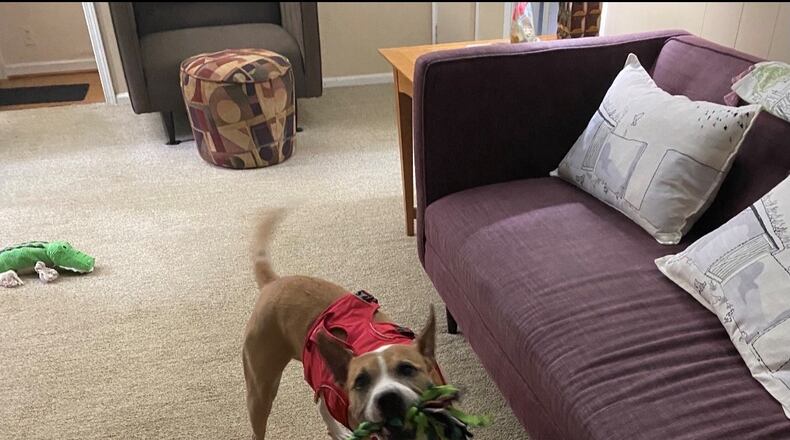Recently, I wandered to the next block calling for our dog, Darla, who had sneaked out our back door.
I saw a woman in front of her house. “Hey, ma’am,” I said, “did you see a three-legged dog stroll by?”
“What kind of dog is it?” she asked.
“Well, she’s a medium-sized, brown ...,” I started explaining, before cutting myself off, figuring there couldn’t have been that many three-legged animals of any kind passing by in the past 10 minutes. “She’s got three legs. Did you see her?”
The fact that she escaped was a sign that the old Darla is back! She was resuming her old tricks — pushing open the back screen door and heading out for adventure. It was a sign of progress, just like her recent inclination to again jump, sniff, dig and circle our wood pile in a never-ending mission to snag a wily chipmunk.
In June, Darla had her front right leg amputated. She had been limping and we brought her to the vet thinking it was some sort of sprain or something. Now, nothing is ever cheap when you visit a veterinarian. Dogs are, in essence, furry money pits, albeit ones that gaze at you fondly while you’re eating a burger or barbecued chicken.
Credit: Natalia Rivera Viscal
Credit: Natalia Rivera Viscal
It turned out Darla had osteosarcoma, an aggressive form of bone cancer. All dog owners know that something terrible will happen to their beloved pet one day. It’s just part of the deal: You get eight, 10, perhaps 15 years of loyalty and unconditional love and then it’s time for the one-way ride to the vet. It’s a sad inevitability but it’s baked into the deal when you arrive home with that adorable puppy. And it provides a rough, but needed, life lesson for the kids.
What made this all the more startling is that our youngest son, Michael, was diagnosed with osteosarcoma in his leg in 2017. He, too, had been limping. Michael quietly battled the hell out of the disease, displaying humor and understated courage before finally succumbing to it two years later.
The two of them, Michael and Darla, were this/tight. Darla was a pound dog, adopted nine years ago by my daughter, Emma, when still a student at the University of Georgia. I was the lone “no” vote in the family (a 5-1 landslide). I had a hunch that one day my daughter would get a job somewhere and we’d end up with a new pet. Which is exactly what happened.
“Beast” is an apt description for Darla because she is a bulldog mix, 52 pounds of muscle and charm, ready to lick (kiss?) anyone who bends over in her face and will hold her own wrestling (in a rough but largely friendly manner) dogs that outweigh her by 50 pounds.
After the twins moved to college, Michael, our youngest, was our dog whisperer. The two of them were inseparable as they went for long walks, played tug of war with the rope toy (she can dislocate a shoulder) or just snuggled in front of the TV.
Credit: Julie Hodack
Credit: Julie Hodack
I must admit that we are not the most disciplined bunch when it comes to dog training and Darla got more than her share of food scraps while not-so-quietly begging under the dinner table.
When a movie starring Liam Neeson was shot down the block a few years ago, Darla realized there was free food in the offing from friendly film crew members. Years later, a new family bought the house of the film shoot, and the owner once got out of her shower to find Darla there inside begging for a snack.
Her mooching got so bad Darla would even stand in front of our bird’s cage whining, hoping that Maya, our mini-parrot, (yes, another pet left behind by a Torpy youth) would drop her a nugget.
“Darla, you’ve hit a new low,” Michael told her, rolling his eyes.
When Mick got sick, Darla sensed something was up and would absolutely mob him when he returned home from his grueling, dayslong hospital stints. We have several sequences of photos with Mick on the couch being happily terrorized by a dog with her tail whipping ferociously.
The Christmas after Michael passed, my sister Kathleen had a miniature figurine of Michael walking a mini-Darla made. It’s in scale for our Christmas village and spookily authentic-looking, although the scale is a mite off, making him appear like an amiable Incredible Hulk wandering amidst the village denizens.
Credit: Bill Torpy
Credit: Bill Torpy
The initial shock of Darla’s diagnosis, especially the cruel coincidence of the disease, was quickly overcome by a greater and more urgent reality — of dealing with it. Again.
Our first thought, as you might suspect, was that’s it! Why make her suffer? But our son Fred, a fourth-year veterinary student at the University of Georgia, encouraged us to go another route. He said that dogs are resilient, adaptable and have short memories. (That is, other than remembering that film crew members once fed her down our block.)
We dropped Darla off at UGA’s veterinary clinic and she got the operation, and three days later, we had a three-legged dog living with us.
The first night, my wife, Julie, slept in a guest bedroom downstairs with Darla in her own bed on the floor. Later that night, I sensed something as I slept upstairs. I flipped on the light and there she was, wondering why her bed wasn’t up there. (I am assuming that’s what she wondered. She never responds to my questions, even when I ask, over and over: “Who’s a good girl?”)
The improvements have been steady and the old girl is back. When we walk, Darla, a muscular and stubborn specimen, has reverted to her habit of stopping, digging in and pulling hard when she doesn’t want to continue or has another route in mind. Normally, a sharp yank of the leash would let her know that she’s not the boss of me. But now I must be more savvy. I can’t pull too hard and have her topple on her chin. I don’t want the neighbors thinking less of me.
Also, she’s a hit wherever she goes. After an initial double take on the street, complete strangers are quick to smile and approach asking to pet her or offering a kind word.
Dr. Spencer A. Johnston, head of UGA’s small animal medicine and surgery department, says animals can teach us something. They’re able to move on quickly from pain and travail. “Dogs and cats are really three-legged creatures with a spare,” he said, repeating a common adage I have noticed now having joined the Tri-pawed community.
Credit: Bill Torpy
Credit: Bill Torpy
After an amputation, “they do not have much of a remembrance of time of having a limb,” Johnston told me. “They don’t pine for that lost limb. There’s no emotional burden of what they used to have. They get up, realize that’s what it is and get on with it.
“They problem-solve: It’s ‘I have to get over there to eat.’ So they do.”
I suppose the term “dogged” was coined for a reason.
The amputees’ owners take it all a lot more to heart. Initially. Then they quickly realize their beloved — and often pampered — pooches are tougher than they thought and are quick to bounce back.
Owners, Johnston said, often report feeling proud of their pets. “We, as humans, like to think that if we faced that kind of adversity, we could handle it as well as they,” he said.
I know we had a kid who faced such misfortune well. Good to see his beloved dog do the same.
About the Author
Keep Reading
The Latest
Featured






